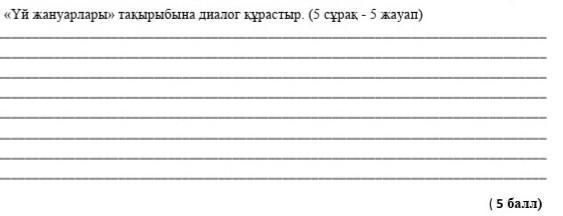Предмет: Қазақ тiлi,
автор: Ninja786
ПОМОГИТЕ ПОЖАЛУЙСТА СРОЧНООО
Приложения:

Ответы
Автор ответа:
1
Ответ:
-Сәлем ит
-Сәлем ат
-Ит сен не істеп отырсың?
-Мен шөп жеп
-Дәмі жаман ғой сүйек тәтті
-Бәрі тәтті.Сау бол ит
-Сау бол ат
Объяснение:
kasaubaevaulbosyn:
Ой негізгі ат
Похожие вопросы
Предмет: Английский язык,
автор: zhilin2000andr
Предмет: Русский язык,
автор: Cat508
Предмет: Русский язык,
автор: Sunwells
Предмет: Математика,
автор: Katënok100303
Предмет: Информатика,
автор: GovherSalmanova